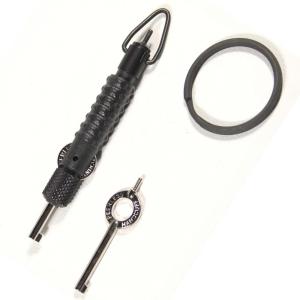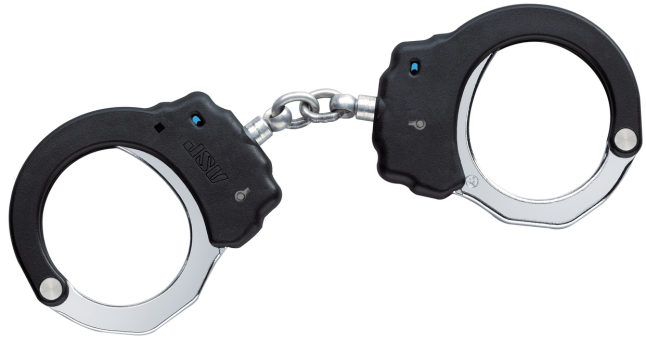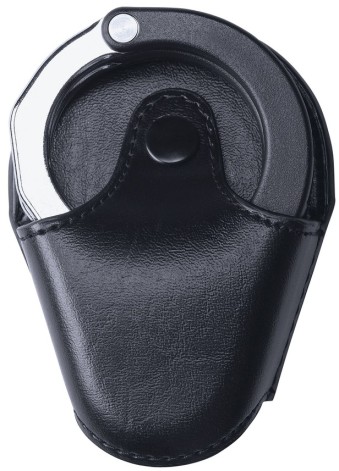
I promised a couple posts back that I would explore handcuffs more in-depth. My previous article explored common mistakes most security personnel make when purchasing and using cuffs, however in this article I will focus more on what I carry, how I carry it, and why.
First, let’s cover some general information.
Selecting your cuffs:
There are three common types of handcuffs available on the market. They are:

Chained:
The most common type of handcuff available, these are the ones you’ll see most often. They are two metal bracelets joined by a short chain, no more than three or four inches apart.
- Pros: Easier to apply to a resistant subject
- Cons: Offers less control after application (subject has great flexibility of movement)

Hinged:
These are the second most popular handcuffs you’ll find. Similar to chained handcuffs, the center portion of these restraints are hinged, and can only be manipulated along those hinges (i.e. folded in half).
- Pros: Offers increased control of a subject after proper application
- Cons: More difficult to apply to a resistant subject

Disposable:
Available in a wide variety of designs, these single-use cuffs are made from cheap materials, most often plastic (although some models use rubber, string or even velcro).
- Pros: Extremely portable, lightweight, easy to carry and conceal
- Cons: Extremely difficult to apply to a resistant subject and offers minimal post-arrest control
Out of the three types of cuffs described, I highly recommend using just standard chain cuffs. Hinged cuffs will offer you more control over a suspect, yes, but if he or she is resisting so enthusiastically that even after applying chain handcuffs you cannot keep them somewhat subdued, you’re probably doing something horribly wrong and should call the police back (you did contact the police right?) and ask them to please hurry.
Never make disposable restraints your primary carry (or only choice of restraints for that matter) unless you have absolutely no other choice.
Disposable restraints are best applied with the assistance of no less than three personnel present for every one subject that needs to be cuffed. Because of the “slip-through” designs of disposable cuffs, they are extremely hard to apply on someone who is fighting back unless you have sufficient help to hold the arms in place for application.
This is why you will often see only crowd control personnel (and riot police) carrying flex cuffs– they are anticipating a large amount of arrests and have sufficient personnel on available to help apply the restraints.
As I mentioned in that previous article, the top three handcuff manufacturers (in my experience) are:
- Smith and Wesson
- ASP
- Peerless
However, no matter what brand or style restraints you select, always make sure they:
- Can be double-locked
- Accept all standard handcuff keys
- Have minimal exposed sharp edges
Optional, but nice:

Your brand new set of cuffs will undoubtedly come with one or two standard keys, which is nice. However, if you wish to go the extra mile (and you always should), pick up an extended handcuff key. These come in a variety of shapes and designs (often resembling a pen), but all ultimately function the same way by allowing you extra control and leverage when manipulating the keyholes/double-locks. Some have rings integrated into their designs so they can be carried on a set of keys.
You’ll quickly see how much easier it is to double lock and/or adjust cuffs with an extended key after suffering through the motions using the dinky standard-issue ones. The extended keys clip to your belt or pocket easily, and with a decent model selling for around $5-25, there is no excuse to not have one.
The dinky keys, however, make great back-ups for your key rings, or tucked away somewhere. You should always have at least one extra key concealed on your person in case of emergencies.

You’ll ideally want to get some sort of case or pouch to hold your handcuffs. While a good set of cuffs will stand up to plenty of wear and tear, cases offer additional protection and speed their deployment.
There are many different styles and iterations of handcuff holders available on the market, but essentially they all function the same. You may wish to purchase a case manufactured by a reputable company (or OEM if the cuffs are of a proprietary design) to ensure quality and proper fit.
What I carry:
Note: Please know that I have no affiliations with ASP and that I am not being paid to endorse them. If I recommend them, it’s because I use and trust their equipment.
The best handcuffs (in my opinion) are manufactured by ASP (Armament, Systems and Procedures) Inc. I currently use the chain models and I swear by these things. If you compare these cuffs to just about every other pair of similar restraints on the market, you might just agree with me when I say these are the gold standard in the restraint category:

ASP’s proprietary handcuff design is extremely well-thought out. There are virtually no sharp edges (even the bow teeth are somehow rounded), and the double-lock function is easy to manipulate with an integrated visual reminder to double-lock your cuffs. The keyholes and double lock can be accessed from either side of the cuffs as well. And at under 10 ounces, these are some of the lightest, yet toughest cuffs I’ve ever used. On a typical duty day, I carry two sets on my person.
How I carry:
One of the downsides to the ASP cuffs is that they are slightly larger than a standard sized set of cuffs. This is due to the polymer overlay (the black portion of the cuffs pictured above), which is actually molded over the steel, and allows for a more secure grip and comfortable fit on the restrained subject.

I carry my cuffs in the ASP Federal Case. The one pictured above is leather, however the one I use is made of ballistic nylon, which is much more durable and lighter. I prefer open-top handcuff holders due to their ease of deployment and rapid presentation.
A bonus to all ASP handcuff cases is the hidden pocket on the back, which allows you to conceal a spare key. This is extremely handy to have.
Side-note: Before my current set up, I used standard chained cuffs manufactured by Smith and Wesson. I carried them in an open-top Blackhawk! molded cordura handcuff case. It was an excellent fit and if you can’t spring for the high-end toys (ASP can be pricey), I recommend this option as well.
Where I carry (and why):
With the belt buckle denoting the 12 o’clock position, I carry both pairs of cuffs on my duty belt in their holders at the 1 o’clock and 5 o’clock positions (I’m right-handed). This is what works for me, you’ll want to experiment and see what works for you.
My current configuration denotes the set of cuffs positioned at 5 o’clock as my primary set, with the set at 1 o’clock acting as my back up set. The reason I have them positioned where they are is so that in an altercation, the back up set of cuffs at 1 o’clock can be reached by either hand once I place the suspect in a Position Of Disadvantage (P.O.D). If a suspect is compliant, but still needs to be cuffed, I will go for the 5 o’clock-positioned cuffs with my strong hand.
Avoid positioning your cuffs in a manner that prevents you from reaching a set of cuffs if you’re laying prone (flat on your stomach) or on your back. Additionally, be mindful of the proximity of your cuffs to your spine.
It is generally bad practice to wear any hard equipment near the small of your back at the 6 o’clock position. If you become involved in a physical altercation and you get knocked onto your back, at best it will hurt and maybe take a little bit of fight out of you, and at worst you may suffer a debilitating spinal injury if you impact your equipment just right.
Maintenance:
Even the best set of cuffs can fail without proper maintenance. This is not something you want, especially during a critical incident. This is why it’s always a good idea to carry at least two pairs of restraints on your person if you can– if one fails or isn’t functioning properly, you have a back-up set ready.
Of course, it’s irrelevant how many pairs of cuffs you carry with you if they all function poorly.
The following is pertaining to standard handcuffs and does not apply to other types of restraints.
At least once per day (or more often depending on your usage), you should:
- Cycle the cuffs by pushing the swinging bars through several times to ensure the teeth are ratcheting properly
- Inspect the cuffs for signs of wear, fatigue or exposed sharp edges
- Ensure all moving parts are free of dirt, grime and other foreign matter, including the keyholes
- Test the lock and double-lock mechanisms with a key to ensure everything functions properly
At least once per month (or again, more often depending on your usage), you should:
- Use an old (dry) toothbrush or similar tool to clean out accumulated dirt and other obstructions
- Lubricate all moving parts, including the keyholes
- Sanitize the entire set with rubbing alcohol or similar disinfectant.
That last point is an important one– sanitation. From a common-sense standpoint, it’s a good idea to keep anything you’re carrying on your person as clean as possible.
But what most folks don’t consider is the fact that failure to sanitize your handcuffs can expose you to liability.
If you’ve been in the industry for any amount of time, especially in medium-to-high threat environments, you know that often times the people you arrest won’t be paradigms of hygiene. Quite the opposite in fact– they may have open bleeding sores, scabies, bulbous lumps oozing pus, the list goes on.
If you slap your cuffs on these individuals, those cuffs instantly become biohazards and you’d better clean them before you use them again. If the next person you use those cuffs on catches a blood-borne pathogen or other nasty malady, you could be looking at a negligence lawsuit.
In fact, after each usage of your cuffs, you should always:
- Sanitize them as described above (some agencies go so far as to make an autoclave ultrasonic machine available to their personnel for this very purpose)
- Conduct all mechanism tests and check for malfunctions
As high-quality as a pair of handcuffs may be, they are still pieces of equipment, and all equipment is vulnerable to failure.
Some handcuffs, for instance, can have their double-locks engaged if dropped hard enough. I’ve personally experienced this.
If you are unfortunate enough to attempt to restrain someone with a pair of already-double-locked handcuffs, the force of the bow strike is more than enough to shatter their wrist or forearm bone. And once again, you are exposed to liability.
Further Information:
Thanks for sticking with me through this pretty-long article. I hope it educated you in a way I wish I’d have been in my earlier years.
Below you’ll find links to all the equipment I recommended in this article. In the interest of transparency, I wish to inform you that the links below are Amazon referrals– if you make a purchase through them, a percentage of your sale will go to keeping this site running and fresh content coming.
It costs you nothing and all the prices listed (at the time of this writing) are well below MSRP. Thank you for your support.
My current load-out:
For maintenance:
- Hoppe’s 9 Gun Oil/Lubricant
- I dislike lubricating my handcuffs with WD-40, mostly because I don’t like the black greasy feeling they leave behind. It is, however, officially recommended by Peerless, so you may consider that as another option.
My previous load-out (same key listed above):
- Smith and Wesson Chain Handcuffs
- Blackhawk! Molded Cordura Open Top Handcuff Case
- The same key listed above
Items I’ve seen/heard other cops and security personnel swear by (I have no experience with these but include them for the sake of completion):
Stay safe out there.

[…] of force to gain compliance against the subject(s). No weapons or tools are involved (although restraints may be necessary to retain compliance). Once in control, the Officer disengages and returns to […]
LikeLike
I was curious where to find a bottom loaded handcuff case?
LikeLike
Hi Stephen,
It’s actually much easier than you think– get yourself a standard top-loading case and put it on your belt upside down!
Cheers,
Spencer
LikeLike